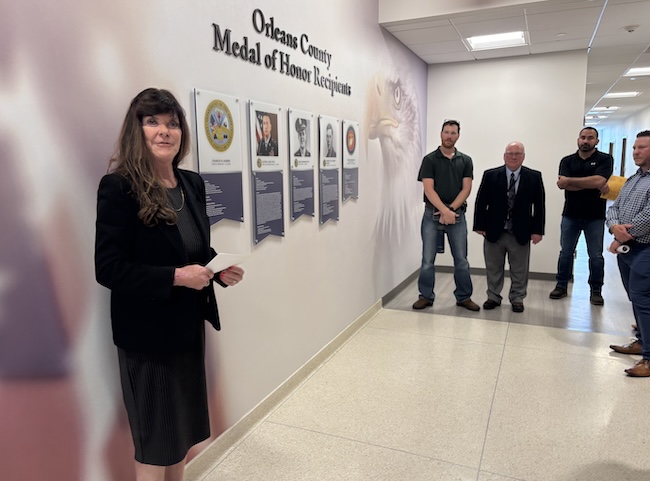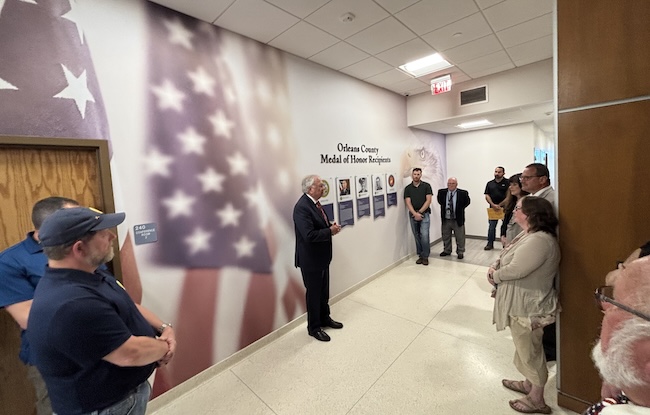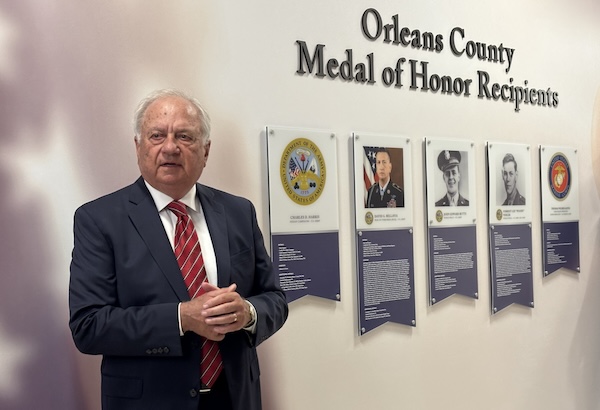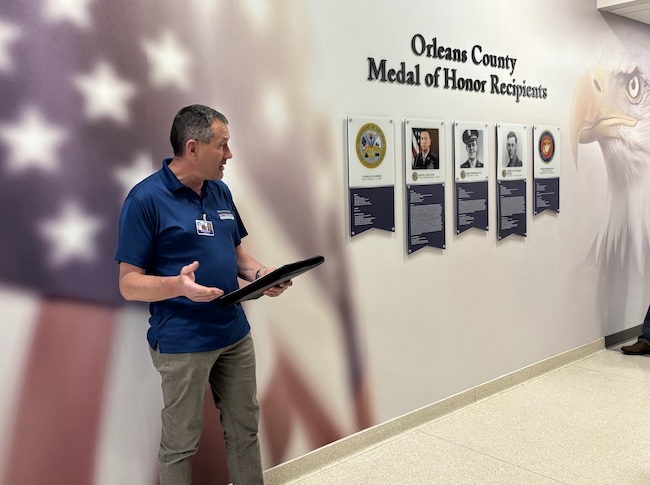County dedicates Medal of Honor Wall with 5 soldiers who received military’s highest distinction
Photos by Tom Rivers
ALBION – Orleans County Legislature Chairman Lynne Johnson speaks during the dedication of the Medal of Honor Wall in the second floor of the County Office Building, outside the legislative chambers.
The wall was dedicated on Tuesday before the Legislature’s monthly meeting.
The county first introduced the wall on March 23, 2022 when a portrait was unveiled of David Bellavia, a Lyndonville native, being presented the Medal of Honor from president Donald Trump on June 26, 2019 at the White House.
The wall now includes all five recipients from Orleans County who received the nation’s highest military honor: Bellavia, Forrest Vosler of Lyndonville, John E. Butts of Medina, Thomas Wilbur Kates of Shelby and Charles D. Harris of Albion.
Takeform in Medina made the plaques and displays on the wall, including the Mystical wallcovering of a bald eagle and American flag. Hilary Misiti served as the project manager for Takeform. Nick Mroz, the Veterans Service Agency director, and Lisa Stenshorn, the clerk of Legislature, also spearheaded the project from the county’s end.
Charlie Nesbitt speaks during the Medal of Honor Wall dedication. Nesbitt is a retired state assemblyman. He also received the Distinguished Flying Cross for heroism as a helicopter pilot in the Vietnam War, for rescuing an American soldier in a hostile enemy zone in the jungles of Laos, across the border from Vietnam. Nesbitt served in Vietnam from May 1968 to May 1969. He flew helicopters that teamed with special forces soldiers.
Nesbitt said the Medal of Honor Wall serves as inspiration to the community, and makes a statement that Orleans County values the commitment of those who serve in the military and the sacrifices of their families.
It is the small towns in places like Orleans County where many often serve on the front lines, making the difference for the country in battle, Nesbitt said.
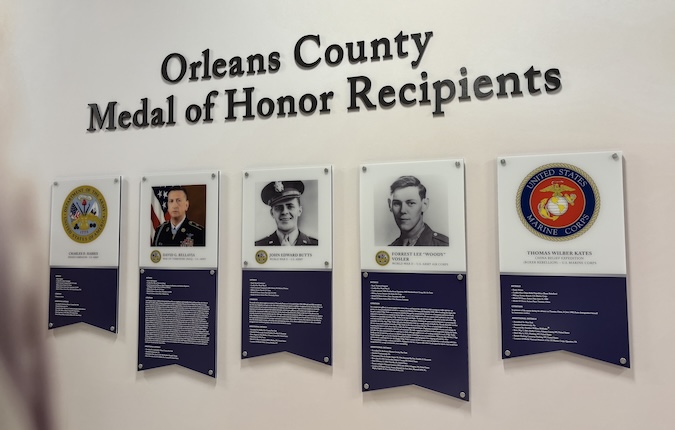
The display includes an updated headshot of Bellavia (second from left) and portraits of Forrest Vosler of Lyndonville (second from right) and John Butts of Medina (center). Photos aren’t available of the other recipients Thomas Wilbur Kates and Charles D. Harris.
The five Medal of Honor recipients include:
• David Bellavia is the first living veteran from the Iraq War to receive the nation’s highest military medal. He was honored for his acts of valor on Nov. 10, 2004 in Fallujah, Iraq. Bellavia led an infantry squad clearing houses of insurgents, saving the lives of the members of his unit.
“That night, Bellavia single-handedly saved an entire squad, risking his own life to allow his fellow Soldiers to break contact and reorganize when trapped by overwhelming insurgent fire,” the U.S. Army states in Bellavia’s Medal of Honor recognition. “He then voluntarily entered and cleared an insurgent strong point, killing four and seriously wounding another. His actions stand as a testament to those who put everything on the line as they do the grim work required to keep each other safe and alive on the battlefield.”
• Forrest Vosler of Lyndonville was assigned as a radio operator and aerial gunner aboard a B-17 Flying Fortress during World War II with the 358th Bombardment Squadron, 303rd Bombardment Group stationed out of England. On Dec. 20, 1943, Vosler’s fourth combat mission. The plane was under fire and had two engines knocked out with the aircraft windmilling out of control.
When a fellow aviator was knocked unconscious, Vosler maneuvered himself into the tailgun. Another 20-mm shell hit the aircraft, sending shrapnel into Vosler’s chest, face, and eyes. He continued to deliver defensive fire upon German aircraft until the attacks subsided. Nearly out of fuel and losing altitude quickly, the crew jettisoned every piece of equipment to lighten the plane.
Vosler, severely wounded and floating in and out of consciousness, begged the crew to throw him out of the plane to reduce weight. As the aircraft plunged into the frigid waters of the North Sea, Vosler crawled out of the aircraft onto a wing. A passing Norwegian trawler quickly picked up the crew and transferred them to a British rescue vessel. One of Vosler’s eyes had one of his to be removed, and the other required extensive surgery.
• John E. Butts of Medina is the only one of the five Medal of Honor recipients from Orleans County who received the honor posthumously. Butts was awarded the Medal of Honor for acts of valor in the Normandy invasion in June 1944.
Butts was in command of four squads in Easy Company of the 60th Infantry Regiment, 2nd Battalion, 9th Infantry Division charged with driving towards St. Colombe, France. On June 12, 1944, 2nd Battalion progressed so quickly towards their objective that the remainder of 9th Division thought the 60th Infantry was lost. In fact, 2nd Battalion had pushed forward through heavy German resistance and established a bridgehead at the Douve River. Butts was wounded twice, first near Orglandes on June 14th and then at the Douve River just two days later; he refused medical treatment on both occasions in order to remain with his men.
On June 23, 1944, the 60th Infantry led the 9th Division’s advance from the Cotentin Peninsula as part of the breakout from St. Lo. While moving towards Flottemanville-Hague, Butts and his men encountered a German stronghold atop a hill, well defended with tanks, machine guns, and mortars. Butts was struck in the stomach by machine gun fire while progressing towards the objective. Pulling himself into the shelter of a nearby hedgerow, he planned a flanking maneuver with his Sergeants.
One squad was to progress up the left flank, another up the right flank, and the third was to remain in reserve. Holding one hand over his midsection and the other grasping his carbine, Butts charged the hill alone. The might of the entire German stronghold fell upon him directly, Butts falling approximately 10 yards from his objective. The distraction allowed the two flanking squads to outmaneuver the Germans while the third squad hit the hill head-on.
Awarded on July 19, 1945 by President Harry Truman, John Butts’ Medal of Honor citation references the two painful wounds he received in the days leading up to the deadly assault on June 23, 1944. His citation concluded by stating, “By his superb courage, unflinching valor and inspiring actions, 2d Lt. Butts enabled his platoon to take a formidable strong point and contributed greatly to the success of his battalion’s mission,” President Harry Truman said in the citation for the medal, which was awarded on July 19, 1945.
• Thomas Wilbur Kates, born in Shelby on May 7, 1865, received the Medal of Honor for his actions in 1900 during the Boxer Rebellion, a nearly two-year uprising led by the Yihetuan (or Boxers) against foreign imperialists in China.
Kates accepted enlistment with the U.S. Marine Corps at New York City on July 21, 1899. Pvt. Kates and other Marines were dispatched to China on June 18, 1900, where they remained through October 10, 1900. According to his citation, Kates was awarded the Medal of Honor “…for extraordinary heroism while serving with the 1st Regiment (Marines), in action in the presence of the enemy during the advance on Tientsin, China, 21 June 1900. Private Kates distinguished himself by meritorious conduct.”
Maj. Waller wrote in a letter dated July 6, 1900, that “…of the men I wish to say, while all in the engagements we participated in, behaved in such a manner as to bring forth the highest praise from the foreign officers…Cpl. Thomas W. Kates.”
He continued, “…the specifically distinguished of these being Corporal Kates and Privates Campbell and Francis, with the Colt gun.” According to the Report of the Commandant of the U.S. Marine Corps dated September 29, 1900, these three men remained with Lt. Powell, holding a position with an M1895 Colt-Browning Machine Gun until all but Campbell and Powell were gunned down. They destroyed the gun to prevent it from entering enemy hands before they commenced their retreat.
• Charles D. Harris, who fought in the Civil War, was awarded the Medal of Honor for his heroism in the Apache Wars in 1869. The specifics of the engagement and the actions that warranted the awarding of the medal remain shrouded in mystery. After the war, Harris returned to Albion and lived a quiet life until his passing on September 6, 1895. He is buried at Mount Albion Cemetery.
(Editor’s Note: Former Orleans County Historian Matthew Ballard researched the four other Medal of Honor recipients from Orleans County. He shared the details in previous columns and presentations when he was historian.)
James Nudd, assistant director of the Veterans Service Agency in Orleans County, speaks during the wall dedication.
“This Medal of Honor memorial is not just a decoration; it is a symbol of all the courage, sacrifice and strength these heroes embodied in those moments, and throughout their service,” Nudd said. “But it is also a reminder of the many others who served alongside them, many of whom never made it home, and many of whom will never have their stories told.”
Nudd said the wall should inspire those who see it, sending a message that bravery is not the absence of fear, but the willingness to act despite of it.
“Let it remind us that the true measure of a person is not found in what they seek for themselves, but it what they are willing to give for others,” he said. “And let it remind us that freedom, peace and security are never guaranteed, but are earned every day by men and women like these, who chose to put the needs of others ahead of their own, without ever asking for recognition.”


























